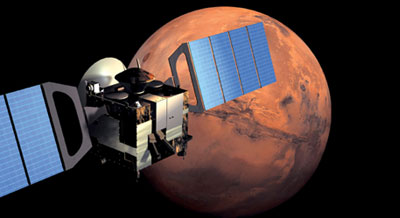|
|
 ESA’s Mars Express mission is far from the last of the agency’s science missions, accordingf to Parker. (credit: ESA) |
Letters: Europe’s space science program
by David Parker
Monday, December 22, 2003
As a European citizen involved in the space science program over here, I find the Space Review interesting and stimulating. However, it does sometimes reflect a rather Americo-centric view of the world, and the article entitled “To Mars, to Mars” by Taylor Dinerman dated Monday, December 15, 2003 has driven me to correct the significant errors in this paragraph:
The European Mars Express/Beagle 2 mission is a first for ESA and is one of the few missions they are doing that conforms to their declared science and exploration role. In fact, given the cuts in space science this may be (along with Rosetta) one of the last classic European space missions. As ESA becomes more of a quasi-military organization and less of a scientific one probes such as these will be less common while their money and effort will go into projects such as Galileo and GMES.
Far from being “one of the last missions”, Mars Express/Beagle 2 is part of a highly successful and continuing space science program that stretches well into the next decade. The funding for space science remains at a consistent level of about 360MEUR per year and is the key mandatory part of the ESA program supported by all the member nations. If you are in the ESA club, you do space science!
To be more specific:
- EADS Astrium is already well advanced in building the Venus Express spacecraft for launch in 2005, which will be the most important atmospheric science mission to Venus yet attempted;
- ESA will launch the Herschel spacecraft to probe the far-infrared universe in unprecedented resolution in 2007, together with Planck, which will map the echoes of the Big Bang visible via the cosmic background radiation.
- In 2007, ESA will also launch the SMART2 science technology mission, which will test the key technologies for the subsequent LISA NASA/ESA gravity wave probe, due for launch in 2012; the SMART 2 payloads will include an important NASA technology package;
- ESA will also start two major Cornerstone missions for launch before 2012; GAIA (to map the positions and motions of a billion stars and thus “weigh” our Galaxy) and Bepi Colombo, which will use electric propulsion to deliver an unprecedented suite of instruments to Mercury and will also “piggyback” a Japanese magnetospheric orbiter;
- ESA will provide one of the three scientific instruments for the NASA James Webb Space Telescope (the Near-Infrared Spectrometer) and ESA member nations are contributing half of a second instrument (the mid-IR instrument);
- ESA is also studying a planet to image exoplanets (Darwin), a mission to Jupiter; a “close-up” Sun mission (Solar Orbiter) and several other innovative programs.
Meanwhile, a long term planetary exploration program, Aurora, is being defined to place Europeans on Mars by 2033, and which starts with a robotic exobiology rover mission (2009) and a Mars Sample Return mission in 2013. You should also note that both GMES and Galileo are firmly civilian programs strongly supported by member nations including the UK.
All of this information is freely available on ESA web sites such as:
http://www.esa.int/export/esaCP/index.html
http://sci.esa.int/science-e/www/area/index.cfm?fareaid=1
http://www.esa.int/export/SPECIALS/Aurora/index.html
Dr. David Parker is the Space Science Key Account Manager for EADS Astrium Ltd in Stevenage, UK.
|
|